苏州的变化
- 格式:docx
- 大小:15.30 KB
- 文档页数:1
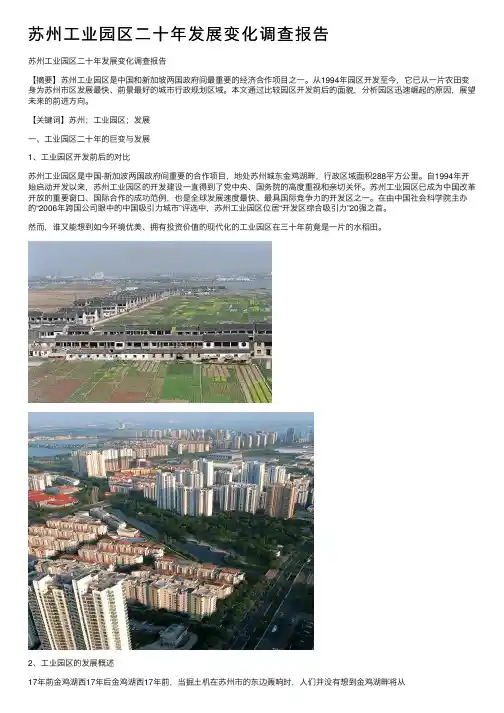
苏州⼯业园区⼆⼗年发展变化调查报告苏州⼯业园区⼆⼗年发展变化调查报告【摘要】苏州⼯业园区是中国和新加坡两国政府间最重要的经济合作项⽬之⼀。
从1994年园区开发⾄今,它已从⼀⽚农⽥变⾝为苏州市区发展最快、前景最好的城市⾏政规划区域。
本⽂通过⽐较园区开发前后的⾯貌,分析园区迅速崛起的原因,展望未来的前进⽅向。
【关键词】苏州;⼯业园区;发展⼀、⼯业园区⼆⼗年的巨变与发展1、⼯业园区开发前后的对⽐苏州⼯业园区是中国-新加波两国政府间重要的合作项⽬,地处苏州城东⾦鸡湖畔,⾏政区域⾯积288平⽅公⾥。
⾃1994年开始启动开发以来,苏州⼯业园区的开发建设⼀直得到了党中央、国务院的⾼度重视和亲切关怀。
苏州⼯业园区已成为中国改⾰开放的重要窗⼝、国际合作的成功范例,也是全球发展速度最快、最具国际竞争⼒的开发区之⼀。
在由中国社会科学院主办的“2006年跨国公司眼中的中国吸引⼒城市”评选中,苏州⼯业园区位居“开发区综合吸引⼒”20强之⾸。
然⽽,谁⼜能想到如今环境优美、拥有投资价值的现代化的⼯业园区在三⼗年前竟是⼀⽚的⽔稻⽥。
2、⼯业园区的发展概述17年前⾦鸡湖西17年后⾦鸡湖西17年前,当掘⼟机在苏州市的东边轰响时,⼈们并没有想到⾦鸡湖畔将从此升起⼀颗璀璨的“明珠”;17年后,3299家外商投资企业⼊驻、累计上交各类税收近1030亿元、创造就业岗位49万个……这颗璀璨“明珠”闪耀出的夺⽬光芒让中国和新加坡两国政府倍感骄傲。
1992年,改⾰开放的总设计师邓⼩平在“南巡讲话”中提出“要借鉴新加坡经验”,于是,在两年之后的1994年,由中新两国政府合作开发建设的苏州⼯业园区破⼟动⼯。
旧貌换新颜,昔⽇的农⽥⽔乡逐渐变成集商务、居住、购物、餐饮、休闲、娱乐、⽂化、旅游于⼀体的现代化新城。
这颗“明珠”由此慢慢绽放出它的光芒。
国际科技园、⽣物纳⽶园、创意产业园、⾦鸡湖⾦融商贸区、独墅湖科教创新区、综合保税区、旅游度假区……17年间,苏州⼯业园区各项发展取得了丰硕的成果,成为名副其实的“改⾰开放试验⽥、国际合作⽰范区”。
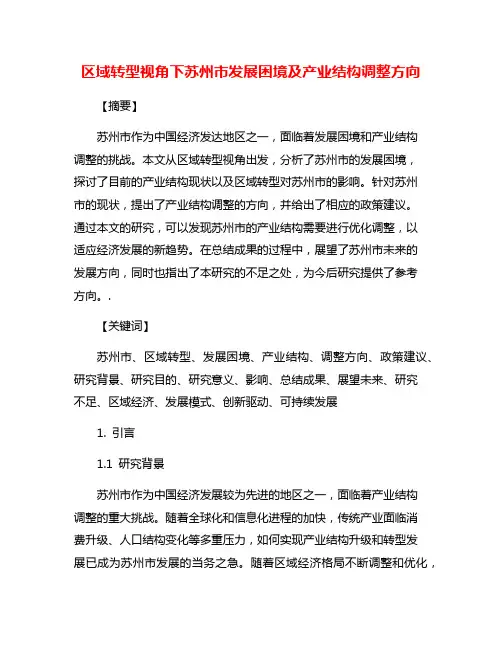
区域转型视角下苏州市发展困境及产业结构调整方向【摘要】苏州市作为中国经济发达地区之一,面临着发展困境和产业结构调整的挑战。
本文从区域转型视角出发,分析了苏州市的发展困境,探讨了目前的产业结构现状以及区域转型对苏州市的影响。
针对苏州市的现状,提出了产业结构调整的方向,并给出了相应的政策建议。
通过本文的研究,可以发现苏州市的产业结构需要进行优化调整,以适应经济发展的新趋势。
在总结成果的过程中,展望了苏州市未来的发展方向,同时也指出了本研究的不足之处,为今后研究提供了参考方向。
.【关键词】苏州市、区域转型、发展困境、产业结构、调整方向、政策建议、研究背景、研究目的、研究意义、影响、总结成果、展望未来、研究不足、区域经济、发展模式、创新驱动、可持续发展1. 引言1.1 研究背景苏州市作为中国经济发展较为先进的地区之一,面临着产业结构调整的重大挑战。
随着全球化和信息化进程的加快,传统产业面临消费升级、人口结构变化等多重压力,如何实现产业结构升级和转型发展已成为苏州市发展的当务之急。
随着区域经济格局不断调整和优化,苏州市的发展也受到了影响,如何抓住发展机遇、应对挑战,成为当前需要探讨和解决的重要问题。
本文旨在通过对苏州市发展困境及产业结构调整方向的深入分析,探讨如何借助区域转型的机遇,推动苏州市产业结构优化升级,实现经济可持续发展。
通过对苏州市产业发展现状、区域转型对其影响及产业结构调整方向的研究,为政府制定相关政策提供参考,为实现苏州市经济高质量发展提供支撑。
1.2 研究目的研究目的旨在深入剖析苏州市当前面临的发展困境,探讨产业结构调整所需的方向与路径,为苏州市的产业升级与经济转型提供决策参考。
通过对苏州市产业结构现状的详细分析,揭示其存在的问题与挑战,分析区域转型对苏州市经济发展的影响,探讨如何通过调整产业结构来增强苏州市的经济竞争力和可持续发展能力。
通过政策建议,为苏州市的产业结构调整提供实实在在的指导和支持,最终实现苏州市经济的转型升级和可持续发展。
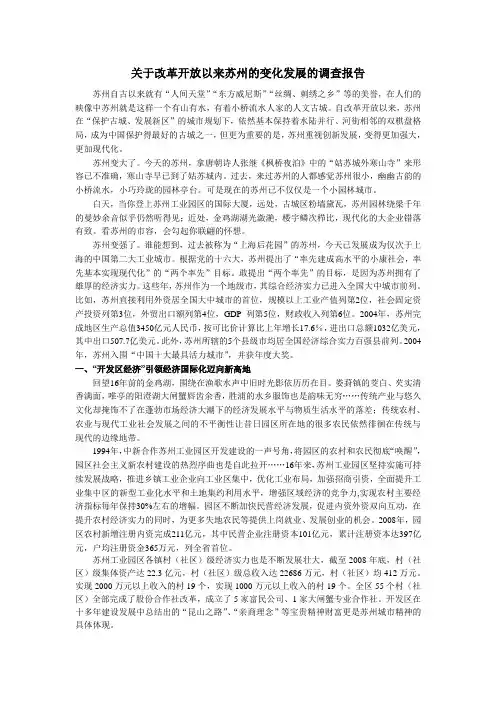
关于改革开放以来苏州的变化发展的调查报告苏州自古以来就有“人间天堂”“东方威尼斯”“丝绸、刺绣之乡”等的美誉,在人们的映像中苏州就是这样一个有山有水,有着小桥流水人家的人文古城。
自改革开放以来,苏州在“保护古城、发展新区”的城市规划下,依然基本保持着水陆并行、河街相邻的双棋盘格局,成为中国保护得最好的古城之一,但更为重要的是,苏州重视创新发展,变得更加强大,更加现代化。
苏州变大了。
今天的苏州,拿唐朝诗人张继《枫桥夜泊》中的“姑苏城外寒山寺”来形容已不准确,寒山寺早已到了姑苏城内。
过去,来过苏州的人都感觉苏州很小,幽幽古韵的小桥流水,小巧玲珑的园林亭台。
可是现在的苏州已不仅仅是一个小园林城市。
白天,当你登上苏州工业园区的国际大厦,远处,古城区粉墙黛瓦,苏州园林绕梁千年的曼妙余音似乎仍然听得见;近处,金鸡湖湖光潋滟,楼宇鳞次栉比,现代化的大企业错落有致。
看苏州的市容,会勾起你联翩的怀想。
苏州变强了。
谁能想到,过去被称为“上海后花园”的苏州,今天已发展成为仅次于上海的中国第二大工业城市。
根据党的十六大,苏州提出了“率先建成高水平的小康社会,率先基本实现现代化”的“两个率先”目标。
敢提出“两个率先”的目标,是因为苏州拥有了雄厚的经济实力。
这些年,苏州作为一个地级市,其综合经济实力已进入全国大中城市前列。
比如,苏州直接利用外资居全国大中城市的首位,规模以上工业产值列第2位,社会固定资产投资列第3位,外贸出口额列第4位,GDP列第5位,财政收入列第6位。
2004年,苏州完成地区生产总值3450亿元人民币,按可比价计算比上年增长17.6%,进出口总额1032亿美元,其中出口507.7亿美元。
此外,苏州所辖的5个县级市均居全国经济综合实力百强县前列。
2004年,苏州入围“中国十大最具活力城市”,并获年度大奖。
一、“开发区经济”引领经济国际化迈向新高地回望16年前的金鸡湖,围绕在渔歌水声中旧时光影依历历在目。
娄葑镇的茭白、芡实清香满面,唯亭的阳澄湖大闸蟹唇齿余香,胜浦的水乡服饰也是韵味无穷……传统产业与悠久文化却掩饰不了在蓬勃市场经济大潮下的经济发展水平与物质生活水平的落差;传统农村、农业与现代工业社会发展之间的不平衡性让昔日园区所在地的很多农民依然徘徊在传统与现代的边缘地带。
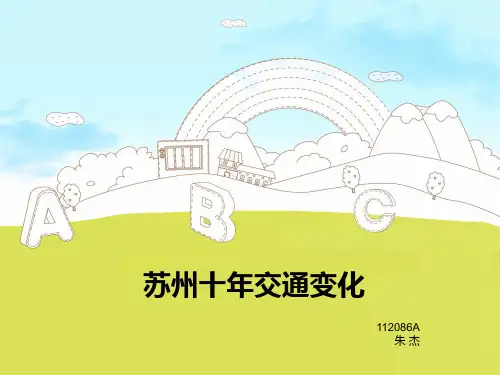
苏州十年交通变化
112086A
朱杰
概要
一、人力车的消失
二、公交车的变化
三、出租车的增加
四、轨道交通的出现
五、长途汽车、铁路的完善
人力车的消失(老苏州的老城区的人力车之前还是非常多的,但现在的苏州只剩下这些旅游区的人力车了)
公交车的变化(老城区的公交站台都是纯苏州古色风情的,而且站台上都有车辆进站的电子牌,公交车从园区到吴中区的都有。
公交的数量从2004年的1500多辆到2004年的4600多辆,而其中线路为300条左右。
)
出租车的增加(数量从2004年2000多辆到现在整个苏州市的7000辆左右,加上现在一些打车软件的出现,现在出租车出行还是很方便的。
)
轨道交通的出现
2012年苏州轨道交通一号线通车,2014年二号线通车,形成纵横交错的两条线2020年苏州的地铁规划图
铁路的完善
苏州旧火车站苏州新火车站
2010年投入使用
目前共有四个:
汽车南站、汽车北站、汽车西站、吴中站
Thank You!。
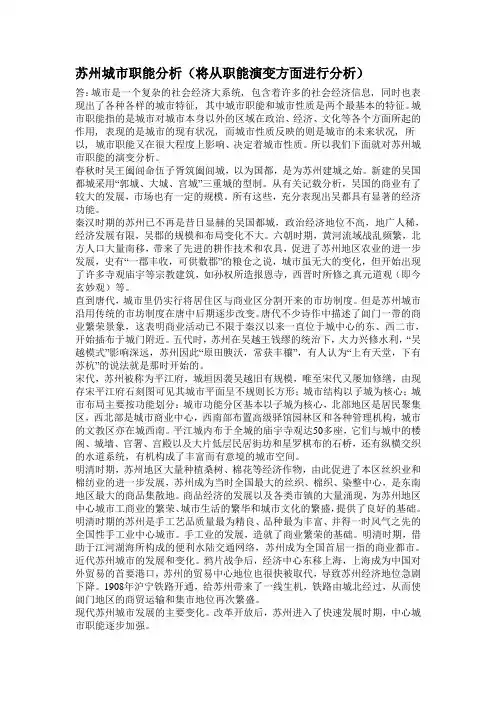
苏州城市职能分析(将从职能演变方面进行分析)答:城市是一个复杂的社会经济大系统, 包含着许多的社会经济信息, 同时也表现出了各种各样的城市特征, 其中城市职能和城市性质是两个最基本的特征。
城市职能指的是城市对城市本身以外的区域在政治、经济、文化等各个方面所起的作用, 表现的是城市的现有状况, 而城市性质反映的则是城市的未来状况, 所以, 城市职能又在很大程度上影响、决定着城市性质。
所以我们下面就对苏州城市职能的演变分析。
春秋时吴王阖闾命伍子胥筑阖闾城,以为国都,是为苏州建城之始。
新建的吴国都城采用“郭城、大城、宫城”三重城的型制。
从有关记载分析,吴国的商业有了较大的发展,市场也有一定的规模。
所有这些,充分表现出吴都具有显著的经济功能。
秦汉时期的苏州已不再是昔日显赫的吴国都城,政治经济地位不高,地广人稀,经济发展有限,吴郡的规模和布局变化不大。
六朝时期,黄河流域战乱频繁,北方人口大量南移,带来了先进的耕作技术和农具,促进了苏州地区农业的进一步发展,史有“一郡丰收,可供数郡”的粮仓之说,城市虽无大的变化,但开始出现了许多寺观庙宇等宗教建筑,如孙权所造报恩寺,西晋时所修之真元道观(即今玄妙观)等。
直到唐代,城市里仍实行将居住区与商业区分割开来的市坊制度。
但是苏州城市沿用传统的市坊制度在唐中后期逐步改变。
唐代不少诗作中描述了阊门一带的商业繁荣景象,这表明商业活动已不限于秦汉以来一直位于城中心的东、西二市,开始插布于城门附近。
五代时,苏州在吴越王钱缪的统治下,大力兴修水利,“吴越模式”影响深远,苏州因此“原田腴沃,常获丰穰”,有人认为“上有天堂,下有苏杭”的说法就是那时开始的。
宋代,苏州被称为平江府,城垣因袭吴越旧有规模,唯至宋代又屡加修缮,由现存宋平江府石刻图可见其城市平面呈不规则长方形;城市结构以子城为核心;城市布局主要按功能划分:城市功能分区基本以子城为核心,北部地区是居民聚集区,西北部是城市商业中心,西南部布置高级驿馆园林区和各种管理机构,城市的文教区亦在城西南。
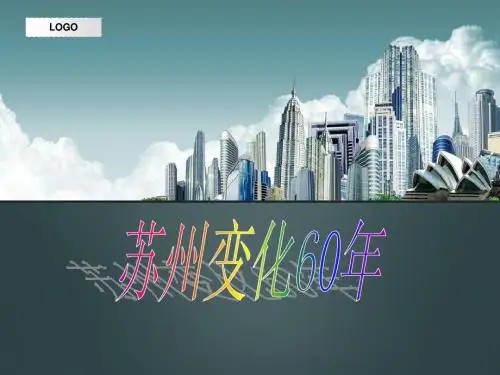
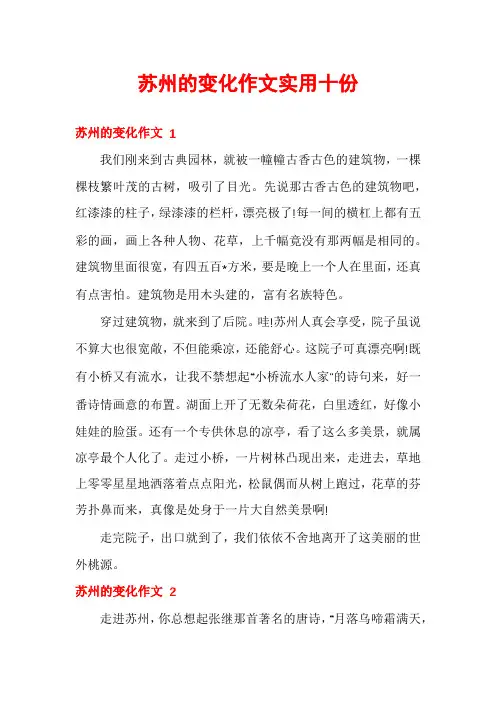
苏州的变化作文实用十份苏州的变化作文 1我们刚来到古典园林,就被一幢幢古香古色的建筑物,一棵棵枝繁叶茂的古树,吸引了目光。
先说那古香古色的建筑物吧,红漆漆的柱子,绿漆漆的栏杆,漂亮极了!每一间的横杠上都有五彩的画,画上各种人物、花草,上千幅竟没有那两幅是相同的。
建筑物里面很宽,有四五百*方米,要是晚上一个人在里面,还真有点害怕。
建筑物是用木头建的,富有名族特色。
穿过建筑物,就来到了后院。
哇!苏州人真会享受,院子虽说不算大也很宽敞,不但能乘凉,还能舒心。
这院子可真漂亮啊!既有小桥又有流水,让我不禁想起“小桥流水人家”的诗句来,好一番诗情画意的布置。
湖面上开了无数朵荷花,白里透红,好像小娃娃的脸蛋。
还有一个专供休息的凉亭,看了这么多美景,就属凉亭最个人化了。
走过小桥,一片树林凸现出来,走进去,草地上零零星星地洒落着点点阳光,松鼠偶而从树上跑过,花草的芬芳扑鼻而来,真像是处身于一片大自然美景啊!走完院子,出口就到了,我们依依不舍地离开了这美丽的世外桃源。
苏州的变化作文 2走进苏州,你总想起张继那首著名的唐诗,“月落乌啼霜满天,江枫渔火对愁眠,姑苏城外寒山寺,夜半钟声到客船”,而千百年来,凡是来苏州的游客,都要来枫桥领略一下枫桥的诗情画意。
枫桥在寒山寺北,距山门仅百步之遥,是一座横跨于古运河上的单孔石拱桥。
以其优美古朴的造型、独特的地理位置在苏州众多的古桥中独树一帜,因为大运河在此通过,这里又是官道所在,南北舟车在此交会,旧时每到夜里航道就要封锁起来,这里便成了理想的停息之地,此桥便因此得名为“封桥”,后因张继的诗而易名“枫桥”,并沿袭至今。
正如明朝诗人高启在《枫桥诗》中不无感慨地写道的,“画桥三百映江城,诗里枫桥独有名;几度经过忆张继,乌啼月落又钟声。
枫桥正是以其浓浓的文化气息,独立于苏州城的风景之中。
而当我我寻着诗句找寻着每一处景色,踏上斑秃不*的石阶走上若虹般的石拱桥,在蒙蒙的月色下,仿佛看见诗人寂寞的身影地侯着河边,吟诵那永恒的诗篇,伴着枫桥依旧通明的渔火,看今夜,它又将映照着谁的愁眠苏州的变化作文 3一说到苏州,我的眼前又浮现出那斜塔、异石、绵雨的美丽苏州,看见了那柳绿花红的美丽风景,碧湖如镜,古香斜塔的虎丘。
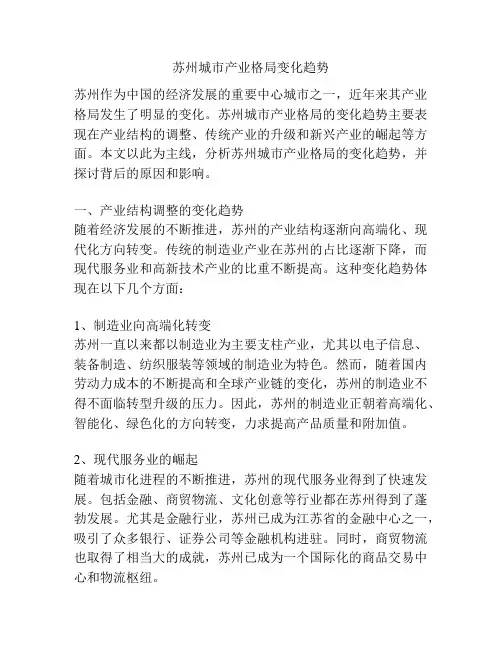
苏州城市产业格局变化趋势苏州作为中国的经济发展的重要中心城市之一,近年来其产业格局发生了明显的变化。
苏州城市产业格局的变化趋势主要表现在产业结构的调整、传统产业的升级和新兴产业的崛起等方面。
本文以此为主线,分析苏州城市产业格局的变化趋势,并探讨背后的原因和影响。
一、产业结构调整的变化趋势随着经济发展的不断推进,苏州的产业结构逐渐向高端化、现代化方向转变。
传统的制造业产业在苏州的占比逐渐下降,而现代服务业和高新技术产业的比重不断提高。
这种变化趋势体现在以下几个方面:1、制造业向高端化转变苏州一直以来都以制造业为主要支柱产业,尤其以电子信息、装备制造、纺织服装等领域的制造业为特色。
然而,随着国内劳动力成本的不断提高和全球产业链的变化,苏州的制造业不得不面临转型升级的压力。
因此,苏州的制造业正朝着高端化、智能化、绿色化的方向转变,力求提高产品质量和附加值。
2、现代服务业的崛起随着城市化进程的不断推进,苏州的现代服务业得到了快速发展。
包括金融、商贸物流、文化创意等行业都在苏州得到了蓬勃发展。
尤其是金融行业,苏州已成为江苏省的金融中心之一,吸引了众多银行、证券公司等金融机构进驻。
同时,商贸物流也取得了相当大的成就,苏州已成为一个国际化的商品交易中心和物流枢纽。
3、高新技术产业的兴起苏州高新技术产业的发展将为城市产业格局的转变提供强大动力。
高新技术产业包括信息技术、生物医药、新材料、新能源等领域,在苏州的发展势头很猛。
苏州工业园区成为了各类高新技术企业的聚集地,其中包括鸿海集团、英特尔等知名企业。
而生物医药产业也取得了很大的突破,苏州成为全国最重要的生物医药产业基地之一。
二、传统产业升级的变化趋势苏州的传统产业也在不断升级中。
传统产业的升级主要体现在工艺、技术和产品结构的改进等方面。
以下是苏州传统产业升级的变化趋势:1、技术升级传统产业要想升级,就必须进行技术创新。
苏州的传统产业包括纺织、制鞋、陶瓷等行业,这些产业不断引进新的设备和工艺,提高产品的质量和生产效率。
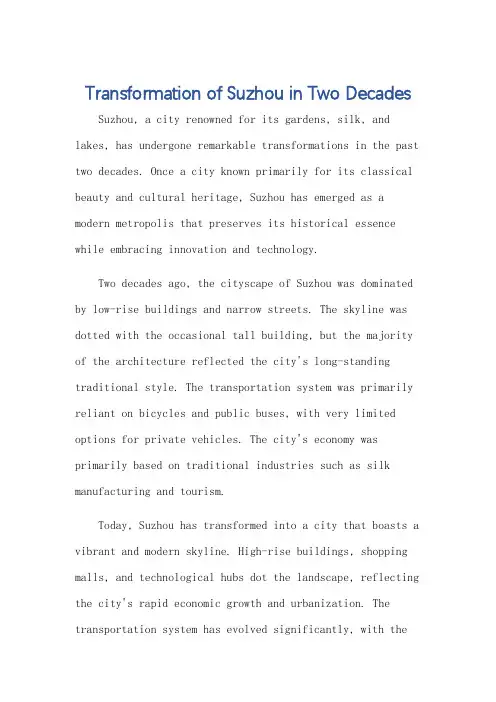
Transformation of Suzhou in Two Decades Suzhou, a city renowned for its gardens, silk, and lakes, has undergone remarkable transformations in the past two decades. Once a city known primarily for its classical beauty and cultural heritage, Suzhou has emerged as a modern metropolis that preserves its historical essence while embracing innovation and technology.Two decades ago, the cityscape of Suzhou was dominated by low-rise buildings and narrow streets. The skyline was dotted with the occasional tall building, but the majority of the architecture reflected the city's long-standing traditional style. The transportation system was primarily reliant on bicycles and public buses, with very limited options for private vehicles. The city's economy was primarily based on traditional industries such as silk manufacturing and tourism.Today, Suzhou has transformed into a city that boasts a vibrant and modern skyline. High-rise buildings, shopping malls, and technological hubs dot the landscape, reflecting the city's rapid economic growth and urbanization. The transportation system has evolved significantly, with theaddition of metro lines, highways, and bridges that connect the city to its surrounding regions. Private vehicles are now commonplace, and the city's infrastructure has adapted to accommodate this growth.Despite its modernization, Suzhou has managed to preserve its rich cultural heritage. The city's famous gardens, such as the Lingering Garden and the Humble Administrator's Garden, remain as beautiful and serene as ever. The city has also embraced contemporary art and culture, with new museums, galleries, and performance venues popping up throughout the city. This blend of old and new has made Suzhou a popular destination for both domestic and international tourists.Suzhou's economic landscape has also undergone significant changes. While the city still maintains itssilk industry, it has diversified into high-tech manufacturing, services, and research and development. The addition of new industries has attracted a younger, more educated workforce, further driving the city's economic growth.Environmental sustainability has also become a priority for Suzhou. The city has implemented several green initiatives, such as promoting renewable energy, improving waste management, and enhancing public awareness of environmental conservation. This commitment tosustainability has helped to maintain the city's beautiful natural landscapes, including its famous lakes and canals.In conclusion, the past two decades have seen Suzhou transform from a traditional city known for its cultural heritage into a modern metropolis that preserves its past while embracing the future. The city's rapid urbanization, economic growth, and commitment to sustainability have all contributed to its current status as a leading city inChina and a popular destination for tourists from aroundthe world.**苏州二十年之变**苏州,这座以园林、丝绸和湖泊闻名的城市,在过去的二十年里经历了翻天覆地的变化。
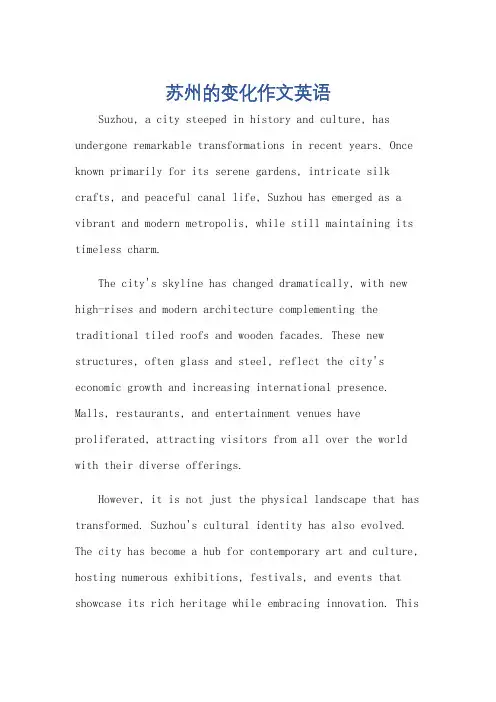
苏州的变化作文英语Suzhou, a city steeped in history and culture, has undergone remarkable transformations in recent years. Once known primarily for its serene gardens, intricate silk crafts, and peaceful canal life, Suzhou has emerged as a vibrant and modern metropolis, while still maintaining its timeless charm.The city's skyline has changed dramatically, with new high-rises and modern architecture complementing the traditional tiled roofs and wooden facades. These new structures, often glass and steel, reflect the city's economic growth and increasing international presence. Malls, restaurants, and entertainment venues have proliferated, attracting visitors from all over the world with their diverse offerings.However, it is not just the physical landscape that has transformed. Suzhou's cultural identity has also evolved. The city has become a hub for contemporary art and culture, hosting numerous exhibitions, festivals, and events that showcase its rich heritage while embracing innovation. Thisblend of old and new has created a unique atmosphere thatis both familiar and fresh.Environmentally, Suzhou has made strides in sustainability. The city has implemented green initiatives and eco-friendly policies, such as promoting renewable energy and enhancing its green infrastructure. This commitment to sustainability is evident in the city's parks, gardens, and clean canals, which provide residents and visitors alike with a pleasant and healthy environment.The transformation of Suzhou is not just a testament to its progress and development; it is also a reflection of China's own rapid transformation. As China has emerged as a global power, Suzhou has become a symbol of its success, balancing tradition with modernity, history with innovation, and sustainability with economic growth.The people of Suzhou have also played a crucial role in this transformation. They have embraced change while maintaining their deep-rooted cultural values. This spiritof resilience and adaptability has been key to the city's success, allowing it to thrive in the face of rapid globalization and modernization.In conclusion, the transformations of Suzhou are not just about bricks and mortar or economic figures; they are about a city's spirit and soul. Suzhou has managed to preserve what is essential to its identity while evolving into a dynamic and forward-looking metropolis. Its story is one of continuous renewal and reimagining, offering a unique and inspiring example of how a city can balance its past with its future.**苏州的变迁:穿越时光之旅**苏州,这座充满历史与文化的城市,近年来发生了翻天覆地的变化。
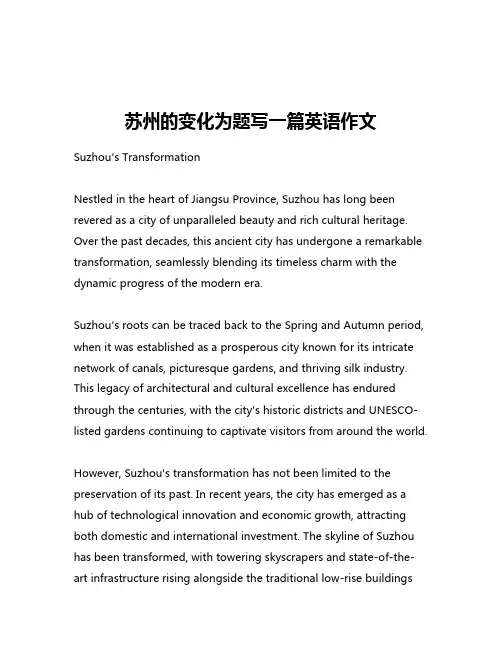
苏州的变化为题写一篇英语作文Suzhou's TransformationNestled in the heart of Jiangsu Province, Suzhou has long been revered as a city of unparalleled beauty and rich cultural heritage. Over the past decades, this ancient city has undergone a remarkable transformation, seamlessly blending its timeless charm with the dynamic progress of the modern era.Suzhou's roots can be traced back to the Spring and Autumn period, when it was established as a prosperous city known for its intricate network of canals, picturesque gardens, and thriving silk industry. This legacy of architectural and cultural excellence has endured through the centuries, with the city's historic districts and UNESCO-listed gardens continuing to captivate visitors from around the world.However, Suzhou's transformation has not been limited to the preservation of its past. In recent years, the city has emerged as a hub of technological innovation and economic growth, attracting both domestic and international investment. The skyline of Suzhou has been transformed, with towering skyscrapers and state-of-the-art infrastructure rising alongside the traditional low-rise buildingsand meandering waterways.One of the most striking examples of Suzhou's evolution is the Suzhou Industrial Park, a joint venture between the governments of China and Singapore. Established in the 1990s, this modern industrial hub has become a shining example of the city's ability to embrace progress while maintaining its unique identity. The park is home to a thriving community of multinational corporations, research institutions, and high-tech startups, all of which have contributed to Suzhou's emergence as a leading center of innovation and economic development.Alongside the growth of its industrial and commercial sectors, Suzhou has also invested heavily in the development of its transportation infrastructure. The city's extensive network of highways, high-speed rail lines, and metro system have greatly improved connectivity, making it easier for residents and visitors to navigate the city and access its various attractions.One of the most notable changes in Suzhou's landscape has been the transformation of its waterways. The city's iconic canals, once the lifeblood of its economy, have been carefully restored and revitalized, with new pedestrian-friendly promenades and leisure activities lining their banks. The ancient art of gondola rowing has been revived, allowing visitors to experience the city's watery heritage in a trulyauthentic manner.Alongside these physical changes, Suzhou has also undergone a cultural renaissance. The city's rich history and traditions have been celebrated and preserved, with local artisans and craftspeople continuing to hone their skills and pass on their knowledge to future generations. Festivals and cultural events, such as the Suzhou Silk Festival and the Suzhou Kunqu Opera Festival, have become increasingly popular, drawing visitors from across China and around the world.Despite the rapid pace of change, Suzhou has managed to maintain a delicate balance between modernity and tradition. The city's historic districts, such as Pingjiang Road and Shantang Street, have been meticulously restored, preserving the charm and character of the city's past while adapting to the needs of the present. New developments, such as the Suzhou Ferris Wheel and the Suzhou Science and Technology Museum, have been designed to complement the city's existing architectural and cultural landmarks, creating a seamless blend of old and new.The transformation of Suzhou has not been without its challenges. As the city has grown and evolved, it has had to grapple with issues such as urban sprawl, traffic congestion, and environmental concerns. However, the local government and its citizens have demonstrated adeep commitment to sustainable development, implementing measures to address these challenges and ensure that Suzhou's growth is both economically and environmentally responsible.In conclusion, Suzhou's transformation over the past decades has been nothing short of remarkable. The city has managed to preserve its rich cultural heritage while embracing the opportunities of the modern era, emerging as a shining example of how a city can balance progress and tradition. As Suzhou continues to evolve, it remains a testament to the power of human ingenuity, resilience, and a deep respect for the past. The city's story is one of continuous reinvention, a living embodiment of the dynamic spirit that has defined Suzhou's journey through the ages.。
苏州的变化作文英语初一Suzhou, a city with a rich history and cultural heritage, has undergone significant changes in recent years. As a first-year junior high school student, I am fascinated by the blend of traditional charm and modern development that defines this city today.Once a city known for its classical gardens and silk industry, Suzhou has now become a hub for high-tech industries and modern architecture. The city's skyline has been transformed with the addition of towering skyscrapers, which stand instark contrast to the low-slung traditional houses andgardens that have been preserved with great care.The canals that once facilitated the transport of silk and other goods now serve as scenic routes for tourists to appreciate the city's beauty. Suzhou's ancient water towns, such as Zhouzhuang and Tongli, have been maintained to showcase the region's past, while new bridges and roads have been built to accommodate the growing population and economy.Education has also seen a revolution in Suzhou. New schools and universities have been established, attracting students from all over the country and abroad. The city's commitmentto education is evident in the state-of-the-art facilitiesand the emphasis on both traditional and modern curricula.Moreover, Suzhou's transportation network has expandedrapidly. The city now boasts a modern metro system that makes commuting efficient and convenient. High-speed rail links have also been established, connecting Suzhou to other major cities in China and beyond.Despite these modern advancements, Suzhou has not lost its soul. The city continues to celebrate its traditional festivals, such as the Suzhou Silk Festival and the Suzhou International Tourism Festival, which draw visitors from around the globe.In conclusion, Suzhou's transformation is a testament to China's rapid development. It is a city that has managed to balance its historical roots with the demands of modern society. As a student, I am proud to witness this evolution and look forward to seeing what the future holds for this dynamic city.。
苏州二十年变迁:一幅繁华与生态共融的画卷In the past two decades, Suzhou, a city renowned forits gardens and canals, has transformed into a dynamic and modern metropolis, while maintaining its unique cultural heritage. This remarkable transformation is a testament to the city's commitment to sustainable development and cultural preservation.**Urban Growth and Development**Suzhou's urban landscape has undergone significant changes. The city's skyline is now dotted with high-rise buildings, shopping malls, and modern infrastructure. This urban growth has not only attracted businesses and investors but has also provided residents with a higher quality of life. The development of public transportation systems, such as subways and buses, has made commuting easier and more convenient.**Cultural Preservation and Tourism**Despite its rapid urbanization, Suzhou has successfully preserved its rich cultural heritage. The city's famousgardens, such as the Lingering Garden and the Humble Administrator's Garden, remain as beautiful as ever, attracting无数visitors from around the world. In addition, the city has also embraced contemporary art and culture, with numerous museums, art galleries, and performing venues dotting the cityscape.**Environmental Protection and Green Initiatives**Suzhou's commitment to sustainability is evident in its various green initiatives. The city has implemented several environmental protection measures, such as water treatment facilities and waste management systems, to ensure a clean and healthy environment. In addition, the city has also promoted green spaces and parks, providing residents with ample opportunities to enjoy the outdoors.**Conclusion**The transformation of Suzhou over the past two decades is a remarkable story of urban growth, cultural preservation, and environmental protection. The city's ability to strike a balance between modernization and tradition has made it a vibrant and sustainable metropolis. As it continues to evolve, Suzhou remains a beacon of hopefor other cities seeking to achieve a harmonious blend of tradition and modernity.**苏州二十年变迁:繁华与生态共融的画卷**在过去的二十年中,以园林和运河著称的苏州已经转型为一个充满活力和现代气息的大都市,同时保留了其独特的文化遗产。
苏州的变化作文在日复一日的学习、工作或生活中,大家都尝试过写作文吧,作文根据体裁的不同可以分为记叙文、说明文、应用文、议论文。
怎么写作文才能避免踩雷呢?以下是小编收集整理的苏州的变化作文,欢迎阅读,希望大家能够喜欢。
苏州的变化作文篇1原来湛蓝的天空,清清河水,树木参天。
随着城市的发展,河水污染,乱伐树木,环境也被大大破坏。
现在,科技发达,人们挖走许多金、银金属等,还有很多煤矿被挖的一干二净,形成地面塌陷,给安全带来了隐患。
许多不可回收的物品,被烧成灰,排到水里和天空里,造成了二次污染。
河水被污染了,河里的小鱼呼吸不到新鲜的空气,就会生病,甚至会死亡,死亡的鱼的尸体再次污染河水,让好多水产品无法生存。
为此,很多同学留心观察,总结了一些经验,展开讨论,便提出合理化建议。
一位大人埋怨说:“城市发展太快,几年来,空气是越来越不好,雾霾十分严重,能见度很低,有时候30米以外的东西都看不见,很危险。
”是的,只要雾一来,就容易发生交通事故,有同学调查,一天最多发生九起事故不只止。
有的同学说:"三年时间内,人们生活的垃圾越拉越多,到处摆着垃圾袋,没有放到统一的地方,路过时发出臭臭的气味,非常难闻。
”还有的垃圾倒到河里,河面飘起五颜六色的赃物,给打捞河面的人带来更大的任务。
地球上,虽然75%是海,但是淡水只有5%,所以保护水资源和保护地球人人有责。
我也有我的观点,许多公司筑起的高楼,砍伐树木,空气得不到净化,人们不能在大树下乘凉,而且也会引起风沙。
最终,大家都提出了自己的宝贵意见:许多水被污染,有些城市有了淡水净化器可以多生产。
大家也要多种树,野外,上坡,沟渠,不要乱伐树木,垃圾不要乱扔,合理处置。
为了苏州的明天天更蓝,水更清,水里的鱼儿更快乐。
我们一起改造环境,保护环境,建设美丽的的水乡努力。
苏州的变化作文篇2今天,爸爸开车带我和妈妈去苏州工业园区的金鸡湖游玩。
在路上,很多新的高楼大厦象春笋拔地而起,道路宽又阔。
苏州的变化
时间:2019-07-15 11:39:52 | 作者:王雨涵
9月28日,阳光明媚,微风阵阵,我们依次上了大巴车。
坐在大巴车上看向窗外,路边的香樟树好似一个个英姿挺拔的士兵保卫着祖国大地,茂密的绿叶沙沙作响,好似在庆祝祖国妈妈的70岁生日。
一个小时后,我们到达了目的地——工业园区苏州广播电视总台。
进入展览馆,首先映入眼帘的是乐意女子中学这几个鲜红的大字,往里走,我们看见了一些形状各异的太湖石,不像玉那般精雕细琢,也不是平常石块那样粗糙,令人赏心悦目。
再往里走,我们看到刚刚改革开放时的一些黑白照片,有热闹的集市、川流不息的人群、叫卖的小摊……左边是一幅栩栩如生的国画,这是清代宫廷画家徐扬所作的《姑苏繁华图》,徐扬画这幅画共用了24年之久,画总长1225厘米,于1759年完工。
这幅画中的人物至少有几百个,每个人物都画得惟妙惟肖,画中的小河、街道,充分体现了苏州昔日的风貌。
上世纪80年代,改革开放给苏州城乡带来了巨大的变化,人民生活日益改善,电风扇、电视机、缝纫机、自行车等物件逐渐走进寻常百姓家,中国人就此开启了改革开放的新征程。
而今的苏州更是令人耳目一新,东方之门、现代传媒广场、环球188、苏州博物馆……在地标里东方之门算知名网红了,绰号“大秋裤”,两条裤腿为南北两楼,是一个外形为门的超高层建筑,总高层达301。
8米,门洞高246米,跨度68米,是世界最大的门型建筑,被誉为“世界第一门”,头顶蓝天、脚踏大地,可威武气派呢!
苏州的变化非常大,我爱苏州!。